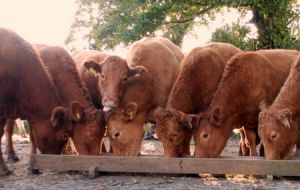MercoPress. South Atlantic News Agency
FAO warns agriculture greenhouse emissions have doubled in 50 years
 Emissions from crop and livestock grew 14% to 5,3 billion tons of carbon dioxide between 2001 and 2011
Emissions from crop and livestock grew 14% to 5,3 billion tons of carbon dioxide between 2001 and 2011  “The increase occurred mainly in developing countries, due to an expansion of total agricultural outputs” said Francesco Tubiello
“The increase occurred mainly in developing countries, due to an expansion of total agricultural outputs” said Francesco Tubiello From farming to forestry and fisheries, agriculture greenhouse emissions have nearly doubled over the past 50 years and may increase by another 30% by 2050, according to new estimates from the UN Food and Agricultural Organization (FAO).
“FAO's new data represent the most comprehensive source of information on agriculture's contribution to global warming made to date,” said Francesco Tubiello of the agency’s Climate, Energy and Tenure Division.
For the first time, FAO has used its own FAOSTAT emissions database to estimate global greenhouse gas emissions from agriculture, forestry and other land use in contributing to the Fifth Assessment Report of the Intergovernmental Panel on Climate Change (IPCC).
Emissions from crop and livestock production grew in 2001 from 4.7 billion tons of carbon dioxide equivalents (CO2 eq) to more than 5.3 billion tons in 2011 – a 14% increase.
“The increase occurred mainly in developing countries, due to an expansion of total agricultural outputs,” FAO said
Meanwhile, net greenhouse gas emissions due to land use change and deforestation registered a nearly 10 percent decrease over the 2001-2010 period – averaging some 3 billion tons CO2 eq year over the decade.
“This was the result of reduced levels of deforestation and increases in the amount of atmospheric carbon being sequestered in many countries,” explained FAO, adding that, “as a result of carbon sequestration in forest sinks, some two billion tons of carbon dioxide were removed from the atmosphere during the same timeframe.”
FAO's data based on country reports show that while those emissions continue to increase, they are not growing as fast as emissions from fossil fuel use in other sectors – actually decreasing over time the share of agriculture and other land use out of total anthropogenic emissions.
The largest source of emissions within agriculture is enteric fermentation – methane produced by livestock during digestion and released via belches. In 2011, this accounted for 39% of the sector's total greenhouse gas outputs and increased 11% between 2001 and 2011.
In 2011, 14% of agricultural emissions (725 Mt CO2 eq.) were generated while applying synthetic fertilizers – the fastest growing emissions source in agriculture – having increased some 37% since 2001.
Greenhouse gases resulting from biological processes in rice paddies that generate methane make up 10% of total agricultural emissions, while burning savannahs accounts for 5%.
FAO data revealed that in 2011, 45% of agriculture-related greenhouse gas outputs occurred in Asia – followed by 25%t in the Americas, five per cent in Africa, eleven per cent in Europe and four per cent in Oceania.
“This regional distribution was fairly constant over the last decade,” the agency noted, adding “in 1990 however, Asia's contribution to the global total [38%] was smaller than at present, while Europe's was much larger [21%].”
The new FAO data also provide a detailed view of emissions from energy use in the agriculture sector generated from traditional fuel sources – including electricity and fossil fuels burned to power agricultural machinery, irrigation pumps and fishing vessels.
“Up to now, information gaps have made it extremely difficult for scientists and policymakers to make strategic decisions regarding how to respond to climate change and has hampered efforts to mitigate agriculture's emissions,” said Mr. Tubiello.
FAO is already generating disaggregated assessments along supply chains and analyzing the effectiveness of comprehensive mitigation interventions in the livestock sector.
Mr. Tubiello explained, “Data on emissions for agriculture, forests and other land use activities support member countries in better identifying their mitigation options and enable their farmers to take faster and more targeted climate-smart responses.”
This improves their overall resilience and their food security and allows the countries to tap into international climate funding and accomplish their rural development goals.
“We also see much interest in capacity development on these topics at country level and respond to these needs through regional and country-level activities around the globe,'' he added.




Top Comments
Disclaimer & comment rules-

-

-

Read all comments“We also see much interest in capacity development on these topics at country level and respond to these needs through regional and country-level activities around the globe,'' he added.
Apr 14th, 2014 - 06:45 pm 0WTF is he trying and failing to say?
50 years ago nobody even knew about “global warming”, the first scare story and wealth generator for the likes of the American crook, the “almost a President” Al Gore and then, because the world was actually COOLING it turned into “climate change”. Now we have farting methane.
And why have we got a big increase in methane? More people in the world and more people have money to eat better. More vegetarians (never thought those poor buggers would be blamed for methane) requiring more crops and the evolution of “synthetic fertilizers”.
The UN are out of control when they publish crap like this.
The latest IPCC Report was a very interesting read full of these lovely thing called facts and evidence unlike this pretty standard ChrisR keeps droning.
Apr 14th, 2014 - 10:43 pm 0Where are you facts ChrisR?
Find a fact-base as comprehensive as the latest IPCC report, or previous ones for that matter, an amount of evidence with as much international recognition as them.
One I posted earlier:
Apr 15th, 2014 - 11:30 am 0'I note that the first state to 'control' methane is Colorado - pretty sparse on cattle feed lots and on water too! Perhaps Cargill know something we don't.
No problem with Methane clathrates in Colorado! ... Now, if Alaska were to get involved, then we could do something to correct matters - but that is REALLY pissing into the wind.
And has ANYBODY found a way to stop cattle from belching and farting us all to a methane rich climate-changed future?'
............
Does anybody know if there is even basic research on livestock production without gastric fermentation?
Apparently a 38% reduction in world levels of anthropogenically produced methane could be brought about if our meat-on-the-hoof could be made 'wind-less'.
Commenting for this story is now closed.
If you have a Facebook account, become a fan and comment on our Facebook Page!